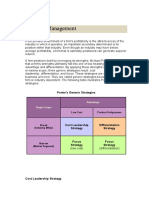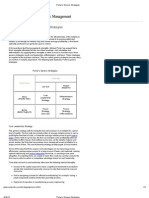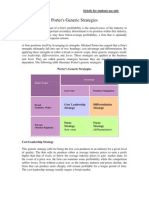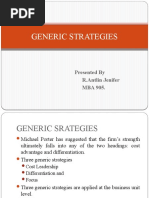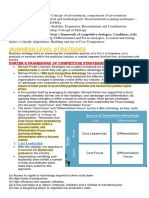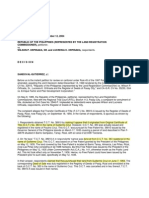Module 3 - Strategy Formulation
Uploaded by
Ronald Reagan AlonzoModule 3 - Strategy Formulation
Uploaded by
Ronald Reagan AlonzoModule 3
Strategy Formulation
MGT 131
STRATEGIC MANAGEMENT
RONALD REAGAN T. ALONZO
Assistant Professor II
LEARNING MODULE
MGT 131: Strategic Management // RRTA 1
Module 3
Strategy Formulation
MODULE 3
STRATEGY FORMULATION
Introduction
This module will look at the difference between business strategy and corporate;
the role of business strategy in achieving competitive advantage; Porter’s generic
competitive strategies and alternative approach to strategy formulation. It will also
look at the industry life-cycle and the Boston Consulting Group portfolio matrix
analysis.
Upon completion of this module you will be able to:
Understand the various levels of business strategy
Understand the nature of environment in which an organization operates
and the role of its analysis in strategy formulation.
Understand that the competitive strategy of an organization and the need
to secure particular competitive advantage over competitors are
important.
Evaluate the industry life cycle
Assess the impact of portfolio analysis Assess the effectiveness of
different growth strategies
MGT 131: Strategic Management // RRTA 2
Module 2: Strategy Formulation
BUSINESS LEVEL STRATEGY
What is business level strategy?
Any given organization may comprise of a number of businesses, each operating
in distinct market and serving different customers. Business level strategy is a
means of separating out and formulating a competitive strategy at the level of the
individual business unit. Competitive strategy is concerned with the basis on
which an organization will compete in its chosen market. The role of business
strategy is to devise a strategy which allows it to compete successfully in the
market place and to contribute to the corporate strategy. The business unit
managers must ultimately show that their business strategy contributes to the
corporate strategy.
In contrast, corporate strategy focuses upon the fundamental question: what
business (businesses) do we want to be in? It is the task of the most senior
executives to formulate a coherent corporate strategy.
Generic Corporate Strategies
Michael Porter identified three generic strategies:
1. Differentiation
2. Focus
3. Low cost
Generic strategies can be applied to broad or narrow markets
Generic strategies can be seen as the value systems or philosophies of the
business
Should be applied to all activities
Basis ofof Competitive
the organisation
Advantage
Cost Differentiation
Broad Lowest cost
Competitive Scope
Differentiation
target leadership
market Stuck in
the middle
Narrow Focus - Focus -
target cost differentiation
market
Figure 3.1 Basis of Competitive Advantage
MGT 131: Strategic Management // RRTA 3
Module 2: Strategy Formulation
DIFFERENTIATION
Differentiation involves the organization competing on the basis of a unique or
different product which is sufficiently valued by consumers for them to pay a
premium price. The product is different to that of competitors and makes it
difficult to imitate. Many ways to differentiate a product or service:
product quality
product reliability
product features
product innovation
service levels
brand name
distribution channels
patent protection
Risks of a differentiation strategy
Difficult to maintain degree of differentiation
Differentiation may not be worth enough to customer to pay premium price
Can be ‘out-differentiated’ by ‘focusers’
FOCUS
Focus strategy occurs when an organization undertake either a cost or differentiation
strategy but within only a narrow segment of the market. E.g. Toyota for hybrid cars
(Camry).
Based on narrow markets
Small organisations or niche marketing
Can be cost-based or differentiation-based
Focus can be achieved by:
narrow product line
customer segmentation
geographic segmentation
focused functional capability
More easily applied in growth industries or fragmented markets
Risks of a focus strategy
MGT 131: Strategic Management // RRTA 4
Module 2: Strategy Formulation
Competition from broad market competitors
Value offered is less than the cost differential
LOW COST
A lower delivered cost structure than competitors
Only one firm can be the lowest cost provider in an industry
Low-cost strategy does not necessarily mean low prices
Can be achieved in many ways:
no frills product
simple product design
cost control
location advantage
production innovation
purchasing cheap assets
government subsidies
experience curve
Risks of a low-cost strategy
Narrow focus on cost control may limit opportunities
Cost leadership may not be sustainable
Competitors pursuing a focus strategy may be able to offer a lower price
LEADERSHIP STRATEGY
A combined strategy of differentiation and low cost
TQM enables companies to produce differentiated goods/services at low cost
Principles of TQM not easily applied to an organisation
Easier to add a differentiation focus to a cost focus
Leader strategies increase competitive nature of an industry
Disadvantage of a leader strategy
Difficult to achieve both differentiation and low cost
Can get ‘stuck in the middle’
MGT 131: Strategic Management // RRTA 5
Module 2: Strategy Formulation
Alternative view to Porter’s generic strategies. Three ways of competing that lead to
excellent performance:
Operational excellence Need to excel on one of these and
Customer intimacy be at industry standard on other two
Product leadership
STUCK IN THE MIDDLE
To avoid being ‘stuck in the middle’ businesses should do at least one of these:
clearly define their business strategy in product-market terms
have a business strategy that delivers unique value to customers
communicate their business strategy to operating staff
implement systems consistent with the defined business strategy
THE INDUSTRY LIFE-CYCLE
The industry life-cycle shown in figure 3.2 below suggests that industries go through
four stages of development as shown below. Within an industry, different strategic
groups may be experiencing different stages of the life-cycle. The life-cycle is frequently
applied to product markets where a product life-cycle can be discerned which follow the
same stages as the industry life cycle. The product life- cycle shown below (figure 3.2)
allows organizations to vary its marketing mix to produce an appropriate response
according to each stage in a product’s development.
MGT 131: Strategic Management // RRTA 6
Module 2: Strategy Formulation
Figure 3.2 Industry Life Cycle
The industry life cycle helps an organization to see how it is positioned in terms of the
development of its market. The different stages of the industry life cycle will have an
impact upon competitive conditions facing the organization. For example one expects
the level of competitive rivalry during the introduction stage, when the market is being
opened up, to be different from that in the maturity stage, when the market is saturated
and the market share comes at the expense of your competitors. There an organization
can benefit from this by understanding the industry life-cycle and formulate the strategy
to match the needs of its stage.
Introduction stage
This is characterized:
By slow growth in sales and high cost as a result of limited production.
Profit will be negative as sales are insufficient to cover the capital outlay on
research and development.
A lot of investment is made by an organization in R&D to make a new product. The
advantage of being a first mover is that an organization may set the industry standards
even in the face of a superior technology. However the tendency is for the product life-
cycle to be compressed, as each stage is cut by rapid change, which means that any
first-mover advantage is quickly eroded. This means that the time scale to recoup
capital expenditure for the first mover is shortened, which brings a grater.
Growth Stage
MGT 131: Strategic Management // RRTA 7
Module 2: Strategy Formulation
The stage is characterized by the following:
Sales increase rapidly as the market grows, allowing companies to reap the
benefits of economies of scale.
Increase in sales brings greater profits which attracts new entrants.
Focus on creating a brand and increase in spending on marketing activities.
The goal of the firm is not merely to attract new customers but to ensure that customers
repeat their purchase.
Maturity Stage
Slowing in sales growth and profits as they become saturated.
Organizations began leaving the industry.
Low cost completion based on efficient production
With exit barriers rivalry become more intense within the industry as marginal
firms find it difficult to exit the industry.
Product may be rejuvenated by finding new customers e.g. Johnson and
Johnson baby oil and Drags deemed unacceptable on health grounds.
Decline Stage
Firms experiences a fall in sales and profitability
Consumer loyalty shifts to new products based on technology
Competition based on price as customers shun old products
Firms continue existing the industry and consolidation may occur to achieve
acceptable profits
The knowledge of the industry life-cycle is useful to help an organization understand
how each stage can affect its competitive environment. In line with its rivals, it must
ensure that its strategy formulation is sufficiently robust to meet the needs of each sage
of the cycle.
MGT 131: Strategic Management // RRTA 8
Module 2: Strategy Formulation
Figure 3.3 Strategy and Issues in the Product’s Life
CORPORATE LEVEL STRATEGY
Corporate level strategy answer the question of how an organization adds value across
the business units that make up the organization which a role of corporate parenting.
This is done by effectively managing the related capabilities in each business units, as
well as leveraging its own management skills across these business units resulting into
synergy. Synergy occurs when the total output from combining businesses is greater
than the output of the businesses operating individually. It is often described
mathematically as 2+2 =5
Growth Strategy
There are four strategies that an organization might follow as shown below:
Table 3.1 Ansoff Matrix (Strategic direction)
MGT 131: Strategic Management // RRTA 9
Module 2: Strategy Formulation
Product/service
Present New
Present Market Penetration Product Development
Market Consolidation
Liquidation
Market Development Diversification
Market Penetration
The strategy of market penetration seeks to increase the market share in its existing
markets by utilizing its existing products. It aims at attracting new customers and getting
existing consumers to increase their usage of the product by improving the quality of the
product, level of service and carrying out promotional activities.
Product Development
This strategy involves developing a new product for the existing market. The ability to
innovate is important for an organization to develop new products. This strategy is most
commonly applied in electronic industry.
Market Development
This strategy is concerned with entering new markets with your existing product. This
may be done by targeting new market segments and new geographical areas or by
devising new users for its products. The existing product may undergo slight
modification to ensure that it fits these new markets better.
Diversification
This occurs when an organization seeks to broaden its scope of activities by moving
into new products and new markets. There are two types of diversification:
MGT 131: Strategic Management // RRTA 10
Module 2: Strategy Formulation
Related diversification is the movement into an industry in which there are some
links with the organization’s value chain. Related diversification can be separated
into vertical and horizontal integration. Vertical integration occurs when an
organization goes upstream i.e. it moves towards its inputs or downstream, i.e. it
moves towards its consumer. Horizontal integration takes place when an
organization takes over a competitor or offers complementary products at the
same sage within the value chain.
Unrelated diversification refers to a situation where an organization moves into a
totally unrelated industry. It is sometimes called conglomerate diversification to
reflect that it involves managing a portfolio of companies.
IMPLEMENTING GROWTH STRATEGIES
The diagram below show the implementation of corporate growth strategies
Business Growth Strategy
Related ( Unrelated
same industry) (different industry)
Horizontal (same Vertical (different stage
stage in supply chain) in supply chain) Conglomerate (few or no
shared competences))
THE BCG MATRIX
Description of the BCG Matrix
MGT 131: Strategic Management // RRTA 11
Module 2: Strategy Formulation
The now well-known BCG tool for portfolio analysis is based on the research by the
Boston Consultancy Group, which investigated the relationships between low costs
(gained from specialisation, scale and experience), market share and market growth.
The ‘product portfolio’ diagram in Figure 3. 4 illustrate the relationships.
To ensure long-term value creation, a company should have a portfolio of products that
contains both high-growth products in need of cash inputs and low-growth products that
generate a lot of cash. The BCG matrix is a tool that can be used to determine what
priorities should be given in the product portfolio of a business unit. It has 2 dimensions:
market share and market growth. The basic idea behind it is that the bigger the market
share a product has or the faster the product’s market grows the better it is for the
company. Product portfolio method placing products in the BCG matrix results in 4
categories in a portfolio of a company:
Figure 3.4 Product Portfolio Diagram
Stars (high growth, high market share) High growth or high-market-share means
that the organisation is gaining experience rapidly, and this experience, or
learning curve, translates into lower costs of one sort or another. However, high
growth and the achievement of a large market share also imply fairly heavy
MGT 131: Strategic Management // RRTA 12
Module 2: Strategy Formulation
expenditure by the firm. The strategic manager will have to judge whether each
product should be further supported, or whether it should be withdrawn.
Stars use large amounts of cash and are leaders in the business so they
should also generate large amounts of cash;
Frequently roughly in balance on net cash flow. However, if needed any
attempt should be made to hold share, because the rewards will be a
cash cow if market share is kept.
Cash Cows (low growth, high market share). The ‘cash cow’, on the other hand,
can bask in the security of a high market share already gained in a market where
other competitors cannot learn very quickly it will provide cash for other projects.
Profits and cash generation should be high and because of the low
growth, investments needed should be low. Keep profits high
Foundation of a company
Dogs (low growth, low market share) A low market-share in a low-growth market
means that not much experience is being gained, so ‘dogs’ can be a drain on
company resources.
Avoid and minimize the number of dogs in a company.
Beware of expensive ‘turn around plans’.
Deliver cash, otherwise liquidate
Question Marks (high growth, low market share). The ‘problem child’ is just such
project, a gamble that may or may not pay off, depending on whether the cost
reductions gained from experience in a high growth market can offset the
expenditure of trying to gain a greater market share. Question marks have the
following characteristics:
Have the worst cash characteristics of all, because high demands and
low returns due to low market share
If nothing is done to change the market share, question marks will simply
absorb great amounts of cash and later, as the growth stops, a dog.
Either invest heavily or sell off or invest nothing and generate whatever
cash it can. Increase market share or deliver cash
Using the BCG Matrix can help understand a frequently made strategy mistake: having
a one-size-fits-all-approach to strategy, such as a generic growth target (9 percent per
year) or a generic return on capital of say 9.5% for an entire corporation. In such a
scenario:
Cash Cows Business Units will beat their profit target easily; their management
has an easy job and is often praised anyhow. Even worse, they are often allowed
MGT 131: Strategic Management // RRTA 13
Module 2: Strategy Formulation
to reinvest substantial cash amounts in their businesses, which are mature and
not growing anymore.
Dogs Business Units fight an impossible battle and, even worse, investments are
made now and then in hopeless attempts to ‘turn the business around.
As a result (all) Question Marks and Stars Business Units get mediocre size
investment funds. In this way they are unable to ever become cash cows. These
inadequate invested sums of money are a waste of money. Either these SBUs
should receive enough investment funds to enable them to achieve a real market
dominance and become a cash cow (or star), or otherwise companies are
advised to disinvest and try to get whatever possible cash out of the question
marks that were not selected.
MGT 131: Strategic Management // RRTA 14
You might also like
- Component Diagnostics: E1 - Engine Control Unit: ECU Pin and PlugNo ratings yetComponent Diagnostics: E1 - Engine Control Unit: ECU Pin and Plug9 pages
- Chapter 1 - Competition and Product StrategyNo ratings yetChapter 1 - Competition and Product Strategy38 pages
- Leadership, Differentiation, and Focus. These Strategies Are Applied at TheNo ratings yetLeadership, Differentiation, and Focus. These Strategies Are Applied at The4 pages
- SG 5 Business Level Strategy Creating and Sustaining Competitive (1)No ratings yetSG 5 Business Level Strategy Creating and Sustaining Competitive (1)11 pages
- Modul MIchael Potter Five Generic Strategy100% (3)Modul MIchael Potter Five Generic Strategy20 pages
- Strategy Formulation at Strategic Business Unit Level0% (1)Strategy Formulation at Strategic Business Unit Level20 pages
- Porter's Generic Competitive Strategies (Ways of Competing)No ratings yetPorter's Generic Competitive Strategies (Ways of Competing)4 pages
- Porter's Generic Strategy Assignment Sir KashifNo ratings yetPorter's Generic Strategy Assignment Sir Kashif2 pages
- Week 13.2 - Business Unit Level StrategyNo ratings yetWeek 13.2 - Business Unit Level Strategy35 pages
- Porter's Generic Competitive Strategies (Ways of Competing)No ratings yetPorter's Generic Competitive Strategies (Ways of Competing)2 pages
- Hairin - A Refinement of Porter's StrategiesNo ratings yetHairin - A Refinement of Porter's Strategies19 pages
- Porter's Generic Competitive Strategies (Ways of Competing)No ratings yetPorter's Generic Competitive Strategies (Ways of Competing)1 page
- Startegic Management - Business Level Strategy NotesNo ratings yetStartegic Management - Business Level Strategy Notes27 pages
- Chapter 4 - STRATEGY FORMULATION AND BUSINESS LEVEL STRATEGIC ACTIONNo ratings yetChapter 4 - STRATEGY FORMULATION AND BUSINESS LEVEL STRATEGIC ACTION6 pages
- SBM Study Manual-Chapter-2 Strategic Choice-Theory & Model PDF100% (1)SBM Study Manual-Chapter-2 Strategic Choice-Theory & Model PDF35 pages
- Generic Strategies: Presented by R.Antlin Jenifer MBA 905No ratings yetGeneric Strategies: Presented by R.Antlin Jenifer MBA 90513 pages
- Strategic Management Competitive AdvantageNo ratings yetStrategic Management Competitive Advantage3 pages
- Porter's Generic Strategies: Cost Leadership DifferentiationNo ratings yetPorter's Generic Strategies: Cost Leadership Differentiation5 pages
- Competition Demystified (Review and Analysis of Greenwald and Kahn's Book)From EverandCompetition Demystified (Review and Analysis of Greenwald and Kahn's Book)No ratings yet
- Module 3 - Product Life Cycle in Theory and PracticeNo ratings yetModule 3 - Product Life Cycle in Theory and Practice11 pages
- Module 5 - A Look at Screening New Product IdeasNo ratings yetModule 5 - A Look at Screening New Product Ideas8 pages
- Module 6 - Understanding Concept Development and Testing100% (1)Module 6 - Understanding Concept Development and Testing11 pages
- Module 2 - Product in Theory and PracticeNo ratings yetModule 2 - Product in Theory and Practice8 pages
- Module 1 - Introduction To Strategic ManagementNo ratings yetModule 1 - Introduction To Strategic Management17 pages
- System, Competence, General Santos City, Region XII, PhilippinesNo ratings yetSystem, Competence, General Santos City, Region XII, Philippines12 pages
- Agrarian Reform Community Connectivity and Economic Support ServicesNo ratings yetAgrarian Reform Community Connectivity and Economic Support Services3 pages
- Electric Drive Ebjc Ebja Ebra Ebjd Repair Manual EngNo ratings yetElectric Drive Ebjc Ebja Ebra Ebjd Repair Manual Eng283 pages
- Compaq CQ42-CQ45-CQ62-QUANTA AX3 WINBLEDON AX3.5 - DA0AX3MB6C2 DDR3 - REV 1A PDFNo ratings yetCompaq CQ42-CQ45-CQ62-QUANTA AX3 WINBLEDON AX3.5 - DA0AX3MB6C2 DDR3 - REV 1A PDF30 pages
- Influence of Certain Psycho-Sociological Variables On English Achievement of Class VIII StudentsNo ratings yetInfluence of Certain Psycho-Sociological Variables On English Achievement of Class VIII Students313 pages
- Cleaning Public Areas: by Mumtazul IlyaniNo ratings yetCleaning Public Areas: by Mumtazul Ilyani27 pages
- Erection Welding Schedule: Revno: Page No. Date Doc No. Prepared Checked (W.T.C) ApprovedNo ratings yetErection Welding Schedule: Revno: Page No. Date Doc No. Prepared Checked (W.T.C) Approved1 page
- How To Add, Subtract, Multiply, Divide in ExcelNo ratings yetHow To Add, Subtract, Multiply, Divide in Excel6 pages
- Topics To Be Covered: Binary Digital Modulation M-Ary Digital Modulation Comparison StudyNo ratings yetTopics To Be Covered: Binary Digital Modulation M-Ary Digital Modulation Comparison Study26 pages
- Lag, Lead, Lead-Lag - Compensation in Control System100% (2)Lag, Lead, Lead-Lag - Compensation in Control System11 pages
- Metal Forming Lecture 3 Stress Strain AnalysesNo ratings yetMetal Forming Lecture 3 Stress Strain Analyses30 pages
- Download Scientific and Technical Translation Routledge Translation Guides First Edition Maeve Olohan ebook All Chapters PDF100% (3)Download Scientific and Technical Translation Routledge Translation Guides First Edition Maeve Olohan ebook All Chapters PDF40 pages
- Mitsubishi Electric Heat Pump Parts Indoor MSZ-GE22-50VA-A1 PDFNo ratings yetMitsubishi Electric Heat Pump Parts Indoor MSZ-GE22-50VA-A1 PDF8 pages
- Lecture Powerpoint: Physics: Principles With Applications, 6 EditionNo ratings yetLecture Powerpoint: Physics: Principles With Applications, 6 Edition21 pages
- Real Time Face Parcing Using Enhanced KNN and DLIBNo ratings yetReal Time Face Parcing Using Enhanced KNN and DLIB6 pages
- Component Diagnostics: E1 - Engine Control Unit: ECU Pin and PlugComponent Diagnostics: E1 - Engine Control Unit: ECU Pin and Plug
- Leadership, Differentiation, and Focus. These Strategies Are Applied at TheLeadership, Differentiation, and Focus. These Strategies Are Applied at The
- SG 5 Business Level Strategy Creating and Sustaining Competitive (1)SG 5 Business Level Strategy Creating and Sustaining Competitive (1)
- Strategy Formulation at Strategic Business Unit LevelStrategy Formulation at Strategic Business Unit Level
- Porter's Generic Competitive Strategies (Ways of Competing)Porter's Generic Competitive Strategies (Ways of Competing)
- Porter's Generic Competitive Strategies (Ways of Competing)Porter's Generic Competitive Strategies (Ways of Competing)
- Porter's Generic Competitive Strategies (Ways of Competing)Porter's Generic Competitive Strategies (Ways of Competing)
- Startegic Management - Business Level Strategy NotesStartegic Management - Business Level Strategy Notes
- Chapter 4 - STRATEGY FORMULATION AND BUSINESS LEVEL STRATEGIC ACTIONChapter 4 - STRATEGY FORMULATION AND BUSINESS LEVEL STRATEGIC ACTION
- SBM Study Manual-Chapter-2 Strategic Choice-Theory & Model PDFSBM Study Manual-Chapter-2 Strategic Choice-Theory & Model PDF
- Generic Strategies: Presented by R.Antlin Jenifer MBA 905Generic Strategies: Presented by R.Antlin Jenifer MBA 905
- Porter's Generic Strategies: Cost Leadership DifferentiationPorter's Generic Strategies: Cost Leadership Differentiation
- Competition Demystified (Review and Analysis of Greenwald and Kahn's Book)From EverandCompetition Demystified (Review and Analysis of Greenwald and Kahn's Book)
- Module 3 - Product Life Cycle in Theory and PracticeModule 3 - Product Life Cycle in Theory and Practice
- Module 6 - Understanding Concept Development and TestingModule 6 - Understanding Concept Development and Testing
- System, Competence, General Santos City, Region XII, PhilippinesSystem, Competence, General Santos City, Region XII, Philippines
- Agrarian Reform Community Connectivity and Economic Support ServicesAgrarian Reform Community Connectivity and Economic Support Services
- Electric Drive Ebjc Ebja Ebra Ebjd Repair Manual EngElectric Drive Ebjc Ebja Ebra Ebjd Repair Manual Eng
- Compaq CQ42-CQ45-CQ62-QUANTA AX3 WINBLEDON AX3.5 - DA0AX3MB6C2 DDR3 - REV 1A PDFCompaq CQ42-CQ45-CQ62-QUANTA AX3 WINBLEDON AX3.5 - DA0AX3MB6C2 DDR3 - REV 1A PDF
- Influence of Certain Psycho-Sociological Variables On English Achievement of Class VIII StudentsInfluence of Certain Psycho-Sociological Variables On English Achievement of Class VIII Students
- Erection Welding Schedule: Revno: Page No. Date Doc No. Prepared Checked (W.T.C) ApprovedErection Welding Schedule: Revno: Page No. Date Doc No. Prepared Checked (W.T.C) Approved
- Topics To Be Covered: Binary Digital Modulation M-Ary Digital Modulation Comparison StudyTopics To Be Covered: Binary Digital Modulation M-Ary Digital Modulation Comparison Study
- Lag, Lead, Lead-Lag - Compensation in Control SystemLag, Lead, Lead-Lag - Compensation in Control System
- Download Scientific and Technical Translation Routledge Translation Guides First Edition Maeve Olohan ebook All Chapters PDFDownload Scientific and Technical Translation Routledge Translation Guides First Edition Maeve Olohan ebook All Chapters PDF
- Mitsubishi Electric Heat Pump Parts Indoor MSZ-GE22-50VA-A1 PDFMitsubishi Electric Heat Pump Parts Indoor MSZ-GE22-50VA-A1 PDF
- Lecture Powerpoint: Physics: Principles With Applications, 6 EditionLecture Powerpoint: Physics: Principles With Applications, 6 Edition
- Real Time Face Parcing Using Enhanced KNN and DLIBReal Time Face Parcing Using Enhanced KNN and DLIB







